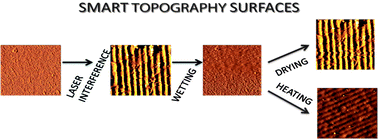Smart surfaces: reversible switching of a polymeric hydrogel topography†
Abstract
Patterns imprinted on smart surfaces are fabricated by direct laser interference

* Corresponding authors
a
Departamento de Química, Universidad Nacional de Río Cuarto, Ruta Nacional 36 Km 601, Río Cuarto, Córdoba, Argentina
E-mail:
cbarbero@exa.unrc.edu.ar
Fax: +54-358-4676233
Tel: +54-358-4676233
Patterns imprinted on smart surfaces are fabricated by direct laser interference

 Please wait while we load your content...
Something went wrong. Try again?
Please wait while we load your content...
Something went wrong. Try again?
M. A. Molina, C. R. Rivarola, M. F. Broglia, D. F. Acevedo and C. A. Barbero, Soft Matter, 2012, 8, 307 DOI: 10.1039/C1SM06191G
To request permission to reproduce material from this article, please go to the Copyright Clearance Center request page.
If you are an author contributing to an RSC publication, you do not need to request permission provided correct acknowledgement is given.
If you are the author of this article, you do not need to request permission to reproduce figures and diagrams provided correct acknowledgement is given. If you want to reproduce the whole article in a third-party publication (excluding your thesis/dissertation for which permission is not required) please go to the Copyright Clearance Center request page.
Read more about how to correctly acknowledge RSC content.
 Fetching data from CrossRef.
Fetching data from CrossRef.
This may take some time to load.
Loading related content
